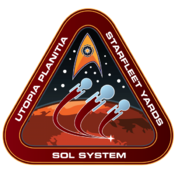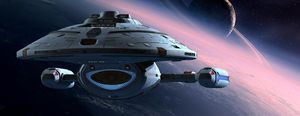Intrepid class/Class Profile
| Utopia Planitia Fleet Yards |
|---|
|
EXPLORERS
In service for a little over two decades, the Intrepid platform continues to be a favorite among both Starfleet captains and engineers, and with good reason. The class itself pioneered many technologies that ships across the fleet take for granted, and its legacy can be seen in the blueprints for ships and classes still on the drawing board. Class IntroductionDuring the early 2360s, Starfleet increasingly found itself in the need for a short-range, nimble, multi-mission starship. Mission types would include intelligence gathering, space defense, short-range scientific exploration, and other "problem solving" missions. Focusing on missions not well-suited for a ship carrying large numbers of civilians, such as a Galaxy class vessel, or where the risk of a larger piece of capital was unacceptable, this new class would need to be a small, adaptable platform sharing many features with Starfleet's beginnings. The class's requirements and needs assessments were laid out in 2361, and the class was officially designated Intrepid in 2362. After initial hull design reviews in 2361 and 2366, the final hull configuration design was completed in 2367. Noting the timeline involved with the Defiant class in development to combat the Borg, many saw and still see the Intrepid as the more traditional explorer compliment to the Defiant class escort of the era. When USS Intrepid was launched in 2370, its time from initial design to launch (9 years, 8 months and 16 days) was a record that has not been broken since. Equipped with bio-neural gel packs (backed up by the fastest main computer of its day) and a class 9 warp drive, the Intrepid class launched as the most advanced and fastest class in the fleet. The class pioneered many other technologies and innovations, including the Mark 1 Emergency Medical Hologram. Due to its agility, adaptability, and proven abilities, the class was put into service during the Dominion War from 2373 to 2375, with the USS Bellerophon serving as the personal flagship of Admiral William Ross during the conflict. Several other vessels of the class served with distinction during hostilities and after the ceasefire. Many of the class's subsystems are the direct ancestors of systems in most modern starships. The discussion of the Intrepid class cannot be complete without mention of the USS Voyager. Voyager itself was the first to test the class 9 warp drive and during its first mission found itself stranded for seven years in the unknown space of the Delta Quadrant. The Intrepid class was designed to refuel, resupply, and have minor repairs every two years. Voyager's seven year mission proved the adaptability of the Intrepid platform to accept new technologies and components and its resilience to survive conditions well beyond those of standard operations. Retrofits from the 2380s to the present have focused on including new platforms such as the quantum slipstream drive, improved hull strength, and quantum torpedo launchers. The success of these upgrades is evidence the Intrepid platform is versatile enough to remain a staple of the fleet for years to come. |
- Black-and-white ship illustrations by Tim Davies unless otherwise noted. Used with permission. All other images are copyright to their respective owners.
- Black-and-white ship illustrations by Tim Davies unless otherwise noted. Used with permission. All other images are copyright to their respective owners.
| REV SD 239308.12 |
|---|


